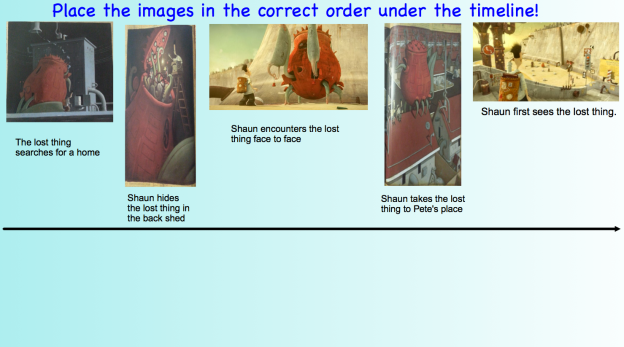My Cambodian Experience
I Am Mark
My First iVideo Production
The Lost Thing IWB Activity

Aim: For students to show their understanding of the book through chronological ordering of images.
Resources: IWB notebook file
Method: Having read the book or short film, students are shown five images that represent different scenes of the story. Students are then required to order the images in chronological order based on how they think the story follows.
Additional Activity: write thought bubbles in each scene of how students think the characters of the story would be thinking.
Android News – For Teachers
Two Useful Blogs for Future Reference
As I was searching for different blogs that I could use for future reference, I found these two.
The first one is very helpful to this subject in general, as it is updated with current technology regarding teaching, and how teachers can bring technology to the classroom and use technology to teach. What is also good about it is that it is designed by a teacher, giving a true perspective on the matter:
http://elemenous.typepad.com/weblog/
This second one is for students that introduces engaging and fun ways of science and maths. The colours, sounds, graphics are great, and the activities are relatively good.
http://www.nasa.gov/audience/forkids/kidsclub/flash/index.html
Literacy Instruction With Digital and Media Technologies Key Ideas
“Kids don’t see laptops, MP3 players, cell phones, PDAs, DVD players, and video games as technology, it’s just life. Schools need to connect education to their students’ lives with technology.” (Wright, 2008)
As we think about using digital media in the classroom, as teachers we have to realise that as technology advances, we could and should change the ways in which we not only teach but assessing as well. For example, when asking students to write an story, conventionally we would ask them to handwrite these, but since most of our writing is done through the computer, we could assess students through typing. This does not mean ONLY using technology as a medium, as it is important to develop handwriting skills, but using a mixture of both digital media and handwriting is useful.
This not only allows introduction and interaction with digital media, but allows constant practice for use on computers and keyboards, as studies have shown that “their speed (in typing on a keyboard) triples by the end of one year through their constant use of the keyboard” (Barone, 2008).
As teachers we need to be able to incorporate technology into our lessons, not as a “computer class” but even in other KLA’s. For example, whilst undergoing comprehension in class, as suggested in the article, one could design a graphical timeline and order the events of the text, using both ICT skills as well as basic comprehension – reading, thinking and showing understanding of the text. Even though it is not the generic Q&A type comprehension task, this task still enables students to read the text, think about the text and respond in an appropriate way
Barone, D., & Wright, T. E. (2008). Literacy instruction with digital and media technologies. The Reading Teacher, 62(4), 292-302
Greenwashing – how media can affect thoughts
Greenwashing is a video that shows how visuals, words and sounds can affect how our subconscious can interpret information and affect how we think. This is important to us as educators because we can see the influence that digital media can have on us, and therefore on our students. We need to be able to teach our students how to critically analyse what they see and hear, so that they are able think clearly, and make better decisions for themselves.
My Definition of “New Literacies”
The term “new literacies” refers to the growing way in which we as people communicate, by sending and/or receiving information to ourselves and between one another. “New literacies” do not have to involve the use of digital media, though as the world advances technologically, our definition of “new literacies’ expands, and at this point in time, digital media is the main way in which we are defining our current “new literacies”. We must understand that technology is not here to take over traditional ways of learning, such as pen and paper, but rather to enhance our learning. Knobel (2006), states that there are two main mindsets of “new literacies”, that one sees the world as much the same as before, though technology has increased, but he also introduces the second mindset that the world is very different from before, largely as a result of technology.
Knobel, M. & Lankshear, C. (2006), Discussing New Literacies. Language Arts 84(1), 78-86